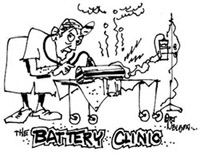Remember when the Litco Alpha
4 was the hottest item in charging? It was so hot that you literally had to win the Litco raffle
to even get one and then be willing to part with $300. This bought you the capability of charging 4 different
packs at the same time. While the Alpha 4 has essentially disappeared from the market the need to charge/cycle various kinds
of packs has not. Hughes R/C www.hughesrc.com has stepped forward to fill that gap. While there are other multiport
chargers available, few if any give you the charge/discharge/cycle control offered by the Hughes Spectra 4 for all the battery
chemistries we are now employing. One of the first things that strikes you when
you get the charger, is the size. This is not a wimpy little charger that you can lose on your charging bench.
Its commanding appearance with large heat sink on one end says serious charging. Turning it on the
first time is another surprise as the display after displaying the Hughes welcome statement with firmware version, scrolled
to “Property of Red Scholefield, Newberry, FL (352) 331-8410. The people at Hughes program the owners information into
each charger sold and can change it if the original owner requests it.
Hughes Spectra 4 charges different chemistries
all at once.
Specifications:
4 Outputs - Manages up
to 4 batteries at one time
1-10 cell NiCad / NiMh
1-4 cell LiPo / Li-Ion / A123
1
- 6 cell Lead Acid
Charger / Cycler */ Loaded Volt Meter
*cycling for 2 or more cells 50 mA – 1000 mA per port (Charge or Discharge)
Input
11-15 VDC
80 character 4 line backlit LCD display
Reverse Polarity Protection on Input and Output
Memorizes up to 20 battery pack charge settings for “AUTOCHARGE”
Remembers packs by NAME not NUMBER
Charges Multiple Batteries
with Common Grounds
Simple 4 button operation, menu driven
Detailed monitoring of all ports
Audible alerts
Battery Backup in case of power failure
Built in Loaded Volt Meter
Fast
charge with peak detection (selectable rates)
Timed
charge (selectable rates)
Topping charge option (selectable rates)
Trickle charge option (selectable rates)
Accurate
battery management
Rugged all metal enclosure
1 Year Warranty
Memorize
up to 20 battery pack charge settings for
"Automatic Charging"
Weight: 2 lbs.
Size:
8” X 5” X 3”
Remembers packs by name not just by
a number
Each pack name can be up to 16 characters long
Memory Examples:
Futaba TX
Extra 300 RX
CAP 232 ignition
All
of the charge parameters measured and recorded appeared to be well within the accuracy limits expected for this type of equipment.
Display features:
The ample display gives you all the information about the
pack. Figure 4 shows the END display for 3 cycles on a 4 cell Ni-Cd pack that had a one flight on it in the morning before
cycling. P3 is for Port 3, CYC indicates there were 3 cycles, the last charge was 1 hour 7 minutes
33 seconds with 736 mAh input. The readings at the bottom were for the capacity delivered on each discharge. The Spectra 4
discharges then charges in the cycle mode.
Battery Back-up Feature.
The Spectra 4 is shipped
with a battery backup lead. Just connect a 7.2 to 12 volt Ni-Cd or Ni-Mh pack to the jack on the left end near the power wire.
In the event of a power failure, the backup battery will continue to power the microprocessor and LCD while terminating all
other functions. When power is restored, all functions will pick up where they left off. Battery backup can save you a lot
of headaches, especially if you are powering your unit from an AC driven power supply, subject to the power company’s
reliability. Your backup battery pack does not need to be large. A 500 mAh pack should keep you going for more than 10 hours
of power failure. When you are doing multiple cycles, battery backup can keep you from having to start over.
Need
more power?
Just connect 2 or more ports together with simple to make harness (detailed at their web
site) and you can charge/discharge up to 4 amps for a single pack, or 2 packs up to 2 amps. Just set the ports to the charge
amount you want to add together. If you want 3500 mA, set 3 ports at 1 amp and one at 500 mA.
A caveat for all chargers. This is the first time
I’ve seen this admitted by any charger manufacturer. From the Hughes Owners Manual “Batteries
should be disconnected from the charger within a reasonable period of time after all functions have been completed. Once “END”
is displayed there will be a small discharge (less than 5 mA) on the battery.” I knew this was the
case with some chargers like the old ACE DVMC. But my curiosity was aroused so I checked a number of other chargers in the
lab. EVERY ONE PUTS A SMALL LOAD ON THE BATTERY WHEN THE CHARGE IS COMPLETE. So if you are using chargers
that do not have a continuous or pulsed trickle charge you could find a pack somewhat discharged if left connected to the
charger for an extended period (4 or 5 days for a 500 mA pack).

